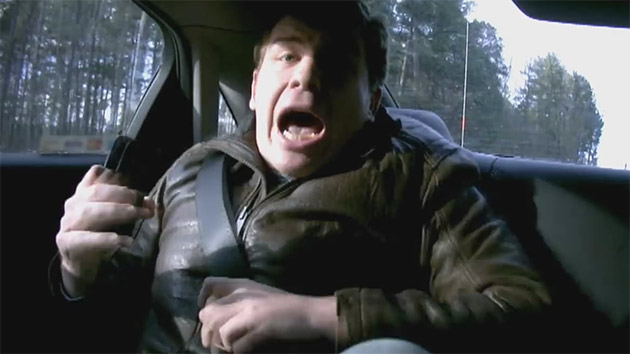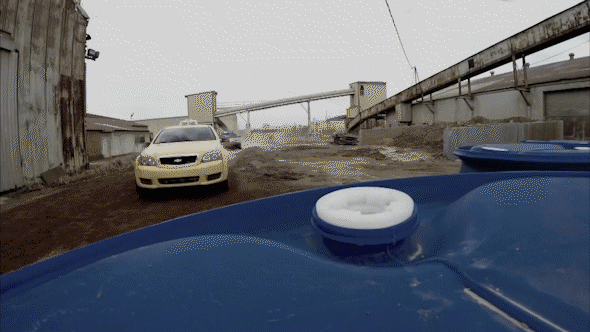Putting an Unsuspecting Car Blogger in the Back as NASCAR Driver Jeff Gordon Flees the Cops
Last May, Pepsi Max (tagline: "a zero-calorie cola in disguise") released a video online that purported to show an unsuspecting car salesman being taken for a wild ride by star NASCAR driver Jeff Gordon in fake facial hair and old-age make-up. The video was a viral hit, racking up more than 40 million YouTube views, but some observers insisted the prank was phony. Among them was Jalopnik blogger Travis Okulski, whose post on the matter described it as "totally 100 percent fake." It took a while, but Pepsi and Gordon had their revenge, devising an elaborate scheme to get Okulski in the back of a "taxi" being driven by Gordon himself, disguised as a heavily tattooed ex-convict cabbie. When the cab is pulled over by a "state trooper," Gordon takes the action offroad with Okulski in tow, saying, "I can't go back — sorry, kid." Things speed up from there as a visibly upset Okulski begs the driver to stop. In less than a week online, the new video has racked up more than 13 million views.
For cinematographer Charles Papert, the challenge was twofold. On the one hand, he had to have the car rigged for video in ways that wouldn't arouse Okulski's suspicion. On the other, he had to prep the rest of the day's shoot, which included a raft of interviews and behind-the-scenes footage as well as capturing the all-important moment when Okulski realized he had been conned by one of the best race drivers in the world. We asked Papert about hiding cameras in a high-performance Chevy Caprice, dumbing down the dash cams, and keeping the mark in the dark.
This is a modal window.
StudioDaily: How did you get the job, and how did you figure out how you were going to approach it?
Charles Papert: The director, Peter Atencio, and I work together on the Comedy Central series Key and Peele. This was the sequel to last year's Pepsi MAX Test Drive spot, which we also did together. That one had a hidden-camera component, but we shot it a bit more traditionally. This one was intended to be an actual, legit prank with hidden cameras that had to be executed with a one-single-take vibe. And that made it much more complicated.
What was the biggest challenge?
Time. I started working on this a bit more than a week before we shot, and there was a tremendous amount to coordinate. I hadn't done much hidden-camera work before — I generally shoot more single-camera narrative style — so I realized I needed to enlist a specialist. Eric Bakke was tech coordinator for Punk'd, among many other things, and he's a great Gene-Hackman-in-The-Conversation character with a phalanx of custom-designed electronic doo-dads and bits and pieces. Right off the bat he was saying, "OK, no problem. We'll get this done."
How long did you have?
I had been told that to properly outfit a vehicle with hidden cameras, it takes two weeks for the build-out. We were looking at two days. The big advantage we had was the taxi partition that was put in, which gave the art department an opportunity. They built three pinhole camera positions into that partition for the back seat. And then there was the up-front master shot with Jeff and Travis, which was extra-important because one of the complaints from last year's spot was that you never saw Jeff driving. So for this one we had to prove that Jeff was driving with Travis in the back seat. That was our most critical angle, and we had a high and wide GoPro hidden up by the visor.
So how many cameras were actually in the car?
The final count was four pinhole cameras and two GoPros. In the divider, we hid a pinhole camera pointed at each of the rear seats, plus another where the divider met the door, which delivered a wide side profile of Travis. Up front, a GoPro built into a GPS mounted on the visor (the high and wide two shot), a pinhole camera in the cell phone holder on the dash (single of Jeff) and a GoPro in the gym bag next to him (low wide shot).
Were you worried about having something out of place that would tip off your mark that the camera was wired for pictures?
There were so many discussions about how to make sure Travis didn't think anything was amiss. He's a car guy, and he makes his living writing about vehicles. So we guessed he was going to recognize this vehicle for what it was–a rare beast [Chevy Caprice PPV] used for police cars. And he did notice. [Okulski later wrote, "I thought it was odd bit figured it came from a police auction or something."] When we had the taxi meter put in by a taxi company, it blew something in the brain of the car that controlled the tachometer and the speedometer. He wrote that he noticed it and thought it was part of a scam where you turn it off to trick the odometer. And the cameras he was completely oblivious to. The art department did an incredible job hiding them.
What kind of cameras were the pinholes?
They deliver 1080 30p and are kind of a "special sauce" that Erik modified a certain amount. We fed them all into [Sound Devices] PIX 240s in the trunk, inside a suitcase that was rigged up in case Travis needed to put luggage in the back. It looked like a suitcase, but it was chock-full of quad splits, PIX 240s, batteries, cables. It was amazing.
What about the logistics of the rest of the shoot?
On top of that, there was a tremendous amount of other business to take care of — mainly plotting the placement and coordination of all of the cameras that weren’t in the car. We had some Bradley Engineering HDC100 pan-and-tilt cameras set up, and we used the Sony F55 and Canon C300, plus the Canon 5D and 7D, for things like shooting Jeff’s make-up, interviews, and of course the final reveal. Everything had to be shot in the same space within a few hours, since we only had Jeff for a short time. We brought along close to 22 cameras, and about 16 of them were actually deployed.
Was it a challenge to get the footage from the different camera types to match?
When you've got so many different sources, sometimes it's a matter of dumbing down one source to match the others. The weakest of these cameras were the pinholes, so they set the tone. They were really desaturated, and the auto-iris didn't respond as well as the GoPros. So everything moved to that look. We shot the GoPros at 2.7K so they could be zoomed into without penalty, but in post there was a certain amount of massaging to the overall look. The State Trooper's dashcam was GoPro, but the resolution was knocked down tremendously and then overlaid with a time-and-date stamp. We cropped it to 4×3, just to get it closer to what we all have in mind from years of watching chase TV shows from the 1990s and 2000s with their crappy dashcam look. And this shoot proved to me, once again, how good these GoPros have gotten. If you want them to look like found footage, you have to cripple them a bit.
Even 10 years ago, you would have thought there was no way to make a camera that small look that good.
It helps that it's a very small aperture, for sharpness, but those cameras continue to astonish me. Last year, on the first Test Drive, we hid one inside a Pepsi can. We had to turn it sideways to make it fit, and I was concerned about how much resolution we would lose extracting a sideways 16×9 frame. When I realized we were shooting 30 frames and could beef up the resolution to 2.7K, that netted us something around 850p — still an acceptable amount of resolution.
What's your favorite moment in the whole piece?
It's when you see the taxi drive through the blue barrels at high speed. It's a slow-motion 120 fps shot, and you can see a GoPro Hero3 get whacked by the rear-view mirror on the driver's side. It goes flying off the edge of the frame. When we came to retrieve it, we couldn't find it. It actually ended up on top of a nearby structure, and the footage was just a mess of rolling shutter artifacts as the camera flew ass-over-teakettle through the air. But I believe that's the only camera you see in the entire thing!
Crafts: Shooting
Sections: Creativity
Topics: Project/Case study charles papert hidden cameras jeff gordon prank viral video
Did you enjoy this article? Sign up to receive the StudioDaily Fix eletter containing the latest stories, including news, videos, interviews, reviews and more.











Leave a Reply